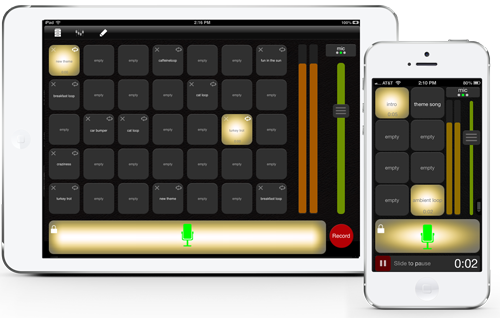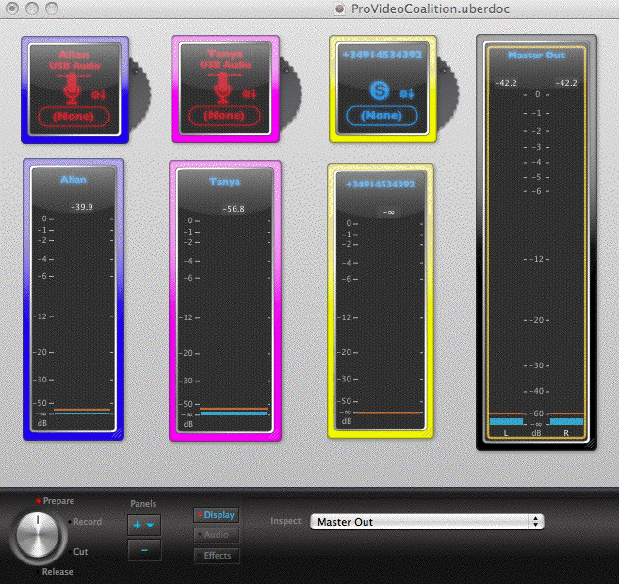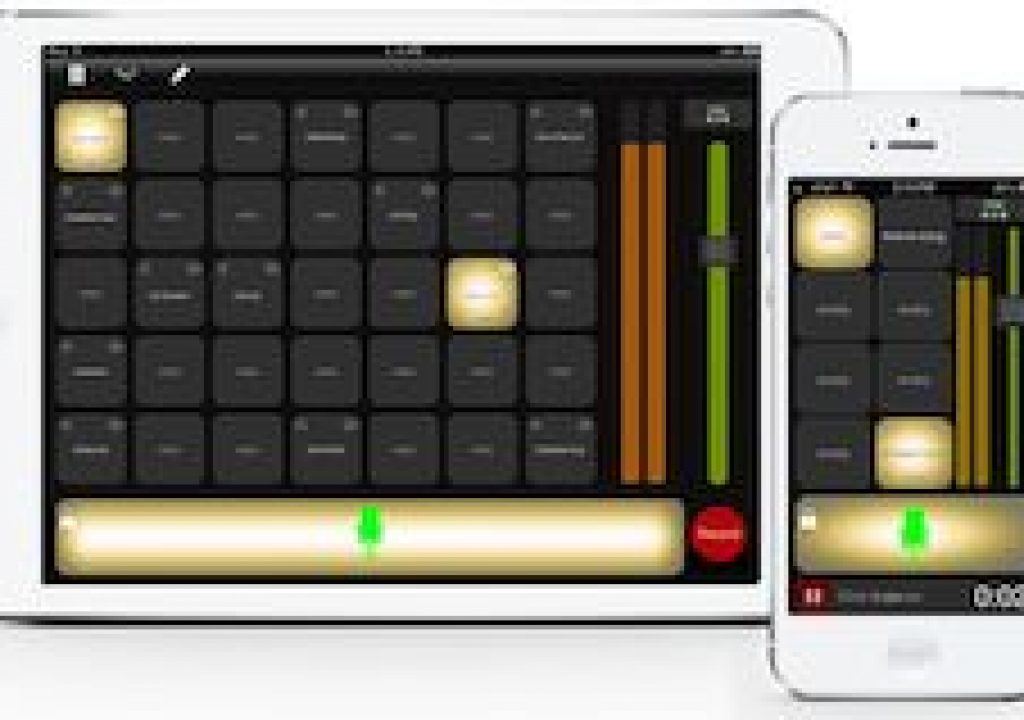
With its inboard virtual carts (to play intros, bumpers, commercial spots, PSAs, sound effects, and stingers), ducking and easy sharing, the under US$10 Bossjock Studio app in your iPad/iPhone/iPod Touch lets you produce your podcast or radio show in real time “live to flash memory”, encode it, and publish it online. This is my “first look” article.
I was intrigued by the Bossjock Studio app when I first became aware of it. Bossjock Studio is an under US$10 (or similar price in your region’s iTunes or iOS AppStore store) destined for audio podcasters (or audio capsule producers for traditional radio) who prefer the simplicity of doing it all “live to flash memory”, or as it is anachronistically known as “live on tape”. In either case, it means that all sound effects, intros, bumpers, commercial spots, sound effects, stingers, outros are handled in real time via virtual carts, with the full intention of not having to edit anything. The main motivation to do it that way is to avoid spending any extra time in post (if at all), and therefore to eliminate the need for retakes.

A view of the Übercaster first step interface. (Übercaster is no longer available.)
Long time readers will recall that there is a different application with a similar goal that I reviewed back in 2009. That app was known as Übercaster, was for Mac OS X (not iOS), and had different features and benefits. Both Übercaster (US$79.95 back then, now no longer available) and Bossjock Studio (under US$10) were designed to create audio podcasts (or audio capsules for other media). Although Übercaster certainly allowed you to record “live to disk”, the existence of Übercaster’s third step (Cut) in its four-step process makes it clear that fine tuning and editing were definitely part of the creator’s plan. Although you could later edit something you recorded with Bossjock Studio (using some external audio editing app), that obviously wasn’t in the creator’s primary design plan. The design plan in Bossjock Studio was clearly to: “Do the entire show in real time, with absolutely all of the enhancements, and just publish it!”. I certainly recognize the benefits of post-production of an audio podcast, but I have learned from personal experience that too much tweaking in post is also quite inefficient, and that the most successful podcasts I listen to weekly are clearly not post-edited (or not much), since they are full of the natural imperfections of “live” production, which undoubtedly feel much more like real life to listeners.
Beyond the simplicity of the lack of post production, iOS-based audio production can be much less costly and contains less margin of error,
especially if you use a single dynamic USB mic connected digitally (like my favorite, the hybrid AT2005USB from Audio Technica) or a USB audio interface (like one of the five I reviewed in this recent article) with XLR microphones (or more than one of the AT2005USB, using their XLR connections).
How to connect two mics to Bossjock Studio and make them both centered?
For productions that are going to be edited later, many people prefer to record each microphone on a separate track to have greater control in post. However, if you plan to record “live to flash memory”, you’ll probably prefer to have each microphone already centered within the stereo image, since that’s the established way of presenting and hearing radio programs and audio podcasts.
If you read my recent article Five iOS-capable, dual-input balanced>USB audio interfaces compared, you might initially think that the only way to make your multiple microphones be centered within the stereo image would be to choose the only mixer in that article that includes a hardware switch for input panning to Left, Center, or Right,
like the US$899 the MixPre-D from SoundDevices. The MixPre-D is a wonderful mixer/interface with many virtues, but if you don’t have one already and cannot justify its price, the creators of Bossjock Studio have good news for you.
As you’ll see in the above screenshot, you can tell Bossjock Studio to treat your microphone input(s) as Dual Mono.
Thanks to the Dual Mono setting in Bossjock Studio, you can use a mixer/interface like the USB Dual Pre from ART for only about US$79.
If you change the option in Bossjock Studio from Stereo to Dual Mono, it will fortunately place both of your microphone(s) in the center. In fact, you can also use the USB Dual Pre and the Dual Mono option in Bossjock Studio to record “live” telephone interviews using an external mobile phone, be it an an Android or an iPhone, or any other mobile phone that doesn’t include sidetone (which is the feature that allows you to hear yourself via the earpiece on most traditional landline phones). This Dual Mono setting affects the way Bossjock Studio treats a stereo mixer that is connected digitally to your iPad/iPhone/iPod Touch, but it fortunately does not affect the way Bossjock Studio treats your virtual carts, where you have your prerecorded intros, bumpers, commercial spots, PSAs, sound effects, and stingers, which are likely to be in stereo. More about the virtual carts in the next section.
A traditional broadcast cart used in radio stations. (Photo courtesy of RPflug, licensed under the Creative Commons Attribution-Share Alike 3.0 Unported, 2.5 Generic, 2.0 Generic and 1.0 Generic license.)
Advantages of built-in virtual carts
Bossjock Studio allows up to 35 carts for you to create in advance. Then you get instantaneous playback of whichever you choose to select. (If you need less virtual carts, you can choose the simplified layout.) That saves you the cost, wiring, and complexity of traditional carts, as originally used in radio stations. In addition, unlike the first mechanical carts I saw in radio stations in the 1980s (which did not have a rewind function, but had to be played until the end of the loop to “recycle” them), the virtual carts in Bossjock Studio are always available and don’t require you to wait real time to “recycle” them. Bossjock Studio even does automatic ducking, which means that as you press the button to activate your microphone, it can automatically lower the volume of the cart so you are heard clearly over the music or sound effect.
Encoding options
Bossjock Studio offers several encoding options, including uncompressed AIFF, WAVE, and compressed M4A and MP3.
Publishing options
Currently, Bossjock Studio offers several publishing options, including email (using the Apple Mail app), Dropbox, FTP, and SoundCloud. SFTP (Secure FTP) is currently missing, which is an important security vulnerability, since with standard FTP, your password travels un-encrypted (in plain text) throughout the Internet, for a hacker to sniff it.
What I’d like to see added to Bossjock Studio
Although I absolutely do recommend Bossjock Studio as it is today, I really hope to see the following features added in the near future:
- SFTP (Secure FTP) to protect our passwords
- Internal software-based audio gating to help reduce crosstalk when using two local microphones connected digitally to the iOS device via a “stereo” mixer/interface
- A preference to set all Bossjock Studio sessions to 48 kHz. Although this is not a must for audio podcasts, it causes no problems for them, and it is the absolute standard for digital audio for digital video. It is attractive to produce simultaneous videos of Bossjock Studio productions and later sync the Bossjock Studio audio recording with the video. However, the current Bossjock Studio records only in 44.1 kHz, even though all current and recent iOS devices support 48 kHz audio, as well as many iOS apps including Auria, FiLMiC PRO, and RØDE REC. The fact that Bossjock Studio currently produces only 44.1 kHz recordings leaves two options: either create a non-standard video at 44.1 kHz, or re-sample the entire production to 48 kHz before syncing with video. Neither is desirable, and that is why I really hope that an upcoming release of Bossjock Studio will offer this option. It’s not about better quality, but better compatibility, and avoiding resampling.
- Compatibility with the Gmail app for email sending, in addition to the Apple Mail app, which exists currently.
Upcoming related articles about Bossjock Studio
Some of the upcoming articles I have planned will cover how to use Bossock Studio with more than two local microphones, how to reduce crosstalk externally of the app, and different ways to publish and trigger the RSS feed.
Upcoming articles, reviews, and books
Stand by for upcoming articles, reviews, and books. Sign up to my free mailing list by clicking here.
Si deseas suscribirte a mi lista en castellano, visita aquí. Si prefieres, puedes suscribirte a ambas listas (castellano e inglés).
My latest book (paperback + ebook)
My most recent book is available in two languages, and in paperback as well as an ebook. The ebook format is Kindle, but even if you don’t have a Kindle device, you can read Kindle books on many other devices using a free Kindle app. That includes iPad, Android tablets, Mac computers, and Windows computers. Although generally speaking, Kindle books are readable on smartphones like Androids and iPhones, I don’t recommend it for this particular book since it contains both color photos and color comparison charts. The ebook is also DRM-free.
In English:
In English, it is currently available in the following Amazon stores, depending upon your region:
- Amazon.com, for the US and other countries in the Americas that don’t currently have their own Amazon store, or anywhere if you simply prefer it
- Amazon.br for Brazil
- Amazon.ca for Canada
- Amazon.de for Germany
- Amazon.es for Spain pero a lo mejor lo preferirás en castellano, a continuación)
- Amazon.fr for France
- Amazon.in for India
- Amazon.it for Italy
- Amazon.co.jp for Japan
- Amazon.com.mx for México
- Amazon.co.uk for the United Kingdom
Or in your favorite bookstore by requesting ISBN–10: 1456310232 or ISBN–13: 978–1456310233.
En castellano:
En castellano, está disponible actualmente en las siguientes tiendas Amazon, según tu región:
- Amazon.com para EE.UU. y todas las Américas donde no existe ninguna tienda particular… o en cualquier parte si simplemente lo prefieres
- Amazon.com.br para Brasil
- Amazon.co.jp para Japón
- Amazon.de para Alemania
- Amazon.es para España
- Amazon.fr (Francia)
- Amazon.in para India
- Amazon.it para Italia
- Amazon.com.mx para México
- Amazon.co.uk para el Reino Unido
o en tu librería preferida al solicitar el ISBN–10: 1492783390 ó el ISBN–13: 978–1492783398.
Allan Tépper’s other books, consulting, articles, seminars & audio programs
Contact Allan Tépper for consulting, or find a full listing of his books, articles and upcoming seminars and webinars at AllanTepper.com. Listen to his TecnoTur program, which is now available both in Castilian (aka “Spanish”) and in English, free of charge. Search for TecnoTur in iTunes or visit TecnoTur.us for more information.
FTC disclosure
No manufacturer is specifically paying Allan Tépper or TecnoTur LLC to write this article or the mentioned books. Some of the other manufacturers listed above have contracted Tépper and/or TecnoTur LLC to carry out consulting and/or translations/localizations/transcreations. Many of the manufacturers listed above have sent Allan Tépper review units. So far, none of the manufacturers listed above is/are sponsors of the TecnoTur programs, although they are welcome to do so, and some are, may be (or may have been) sponsors of ProVideo Coalition magazine. Some links to third parties listed in this article and/or on this web page may indirectly benefit TecnoTur LLC via affiliate programs.
Copyright and use of this article
The articles contained in the TecnoTur channel in ProVideo Coalition magazine are copyright Allan Tépper/TecnoTur LLC, except where otherwise attributed. Unauthorized use is prohibited without prior approval, except for short quotes which link back to this page, which are encouraged!


